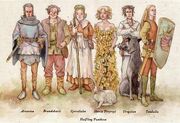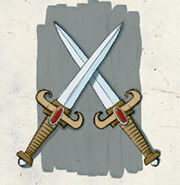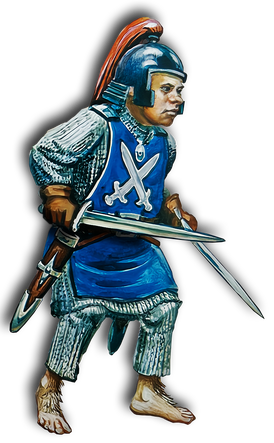Arvoreen (pronounced: /ˈærvoʊrin/ ARR-voh-reen[4]), also known as The Defender or The Wary Sword[4] was the closest the halflings had to a war god, but he was actually the halfling pantheon's deity of defense, guardians, and watchers.[12]
Description[]
The avatar of Arvoreen appeared as a handsome young muscular halfling dressed in light clothing and chain mail. His weapons of choice ranged from two short swords to a short sword and shield. He was always accompanied by a Keeper, and he sometimes appeared to go on patrol with his worshipers.[2]
Personality[]
Arvoreen was strict and preached aggressive watchfulness but only to react to aggression. He didn't support starting conflicts unless it was done to stop evil practices.[2] Arvoreen never attacked first and didn't hold thieving to be dishonorable as long as it was against a foe. However, it was extremely forbidden to steal from the Hin (halflings) or their allies.[13]
Relationships[]

Arvoreen (far left) and the halfling pantheon.
The Defender's enemies were evil deities such as Bane, Cyric, the Deities of Fury, and the goblinoid pantheon. His closest allies were the rest of the hin pantheon, especially Yondalla, Cyrrollalee, and Urogalan, but he disapproved of the behavior of Brandobaris.[4]
Worshipers[]

Holy symbol of Arvoreen.
The faith of Arvoreen was strong in like-minded strongheart halflings and some isolationist halflings. Devotees followed procedures of military drills, training regimens, and building traps, signal beacons, and fortifications. Their temples were specially built keeps. This mix, along with the ideal that the enemies to the hin community mostly came from mixing with other cultures, made them less popular with lightfoots, who stayed away except in times of war.[4]
The followers of Arvoreen also taught blade-work to the young, especially the deity's favored weapon, the short sword. The clergy prayed before dawn, before going on patrol. If able, they would also pray before battle with the Battle Hymn of the Keepers, an oral depiction of halfling military victory dating back centuries.[4]
The vestments of the priesthood were silver-colored chain mail and helmet, along with dark blue tabards with his holy symbol. They also wore an amulet of a small silver buckler.[2]
Specialist priest and worshipers[]

A priest of Arvoreen.
Novices of the church were called "Shieldbearers" and the ranks in order of ascent were: Shieldbearer, Warder, Guardian, Defender, Protector, Magistrate, Sheriff, Marshal (full priest), and High Marshal.[2]
- Trueswords: Specialized priests skilled in fighting with short swords, engineering, and reading and writing.[2]
- Keepers: Elite halfing warriors who'd fallen in battle and patrolled the Green Fields in the afterlife.[2]
- Arvoreen's Warders: A militaristic branch of the religion with less spellcasting ability, who made up for this drawback with tenacity and skills.[14]
Holy Days[]
- Ceremony of Remembrance: This took place during Feast of the Moon, where they remembered those who fell in the defense of the halfling community.[4]
Affiliated Orders[]
- Arvoreen's Marchers: Known for keeping anarchy from spreading during the Tethyrian Interregnum, they then became a recognized knightly order. During this time, they were active in the Purple Hills under the leadership of Estermal Talltankard. They gained a chapter-house near Barrowsmorn, called Keeperstone, and they patrolled the Purple Marches.[2]
Appendix[]
| This article is incomplete. You can help the Forgotten Realms Wiki by providing more information. |
Trivia[]
There is a sling of Arvoreen found in Baldur's Gate II: Shadows of Amn in a beholder den that states falsely that Arvoreen is female.
In the game Neverwinter Nights 2, Daeghun Farlong has an Arvoreen's amulet of aid in a chest in his room. Daeghun never mentions the amulet or how he got it. It is known that Arvoreen grants gifts to defenders of hin communities and that might be how he gained this item.
Further Reading[]
- Roger E. Moore (March 1982). “The Gods of the Halflings”. In Kim Mohan ed. Dragon #59 (TSR, Inc.), pp. 52–55.
- Chris Perry (January 1992). “Defenders of the Hearth”. In Roger E. Moore ed. Dragon #177 (TSR, Inc.), pp. 82–88.
- Eric L. Boyd (November 1998). Demihuman Deities. Edited by Julia Martin. (TSR, Inc.), pp. 162–166. ISBN 0-7869-1239-1.
- Roger E. Moore (March 1982). “The halfling point of view”. In Kim Mohan ed. Dragon #59 (TSR, Inc.), pp. 49–51.
- Thomas M. Costa (July 2004). “Faiths of Faerûn: Arvoreen's Keepers”. In Matthew Sernett ed. Dragon #321 (Paizo Publishing, LLC), pp. 76–79.
- Eric L. Boyd, Erik Mona (May 2002). Faiths and Pantheons. Edited by Gwendolyn F.M. Kestrel, et al. (Wizards of the Coast), pp. 137–138. ISBN 0-7869-2759-3.
References[]
- ↑ 1.0 1.1 Gary Gygax (August, 1985). Unearthed Arcana (1st edition). (TSR, Inc.), p. 115. ISBN 0880380845.
- ↑ 2.00 2.01 2.02 2.03 2.04 2.05 2.06 2.07 2.08 2.09 2.10 Eric L. Boyd (November 1998). Demihuman Deities. Edited by Julia Martin. (TSR, Inc.), pp. 162–166. ISBN 0-7869-1239-1.
- ↑ Thomas E. Rinschler (2001-06-06). Deities (PDF). Wizards of the Coast. p. 3. Archived from the original on 2016-11-01. Retrieved on 2017-07-23.
- ↑ 4.0 4.1 4.2 4.3 4.4 4.5 4.6 4.7 Eric L. Boyd, Erik Mona (May 2002). Faiths and Pantheons. Edited by Gwendolyn F.M. Kestrel, et al. (Wizards of the Coast), pp. 137–138. ISBN 0-7869-2759-3.
- ↑ Eric L. Boyd (November 1998). Demihuman Deities. Edited by Julia Martin. (TSR, Inc.), p. 164. ISBN 0-7869-1239-1.
- ↑ 6.0 6.1 Steve Kenson, et al. (November 2015). Sword Coast Adventurer's Guide. Edited by Kim Mohan. (Wizards of the Coast), pp. 23, 110. ISBN 978-0-7869-6580-9.
- ↑ Mike Mearls, Jeremy Crawford (2014). Player's Handbook 5th edition. (Wizards of the Coast), p. 63. ISBN 978-0-7869-6560-1.
- ↑ Bruce R. Cordell, Ed Greenwood, Chris Sims (August 2008). Forgotten Realms Campaign Guide. Edited by Jennifer Clarke Wilkes, et al. (Wizards of the Coast), p. 64. ISBN 978-0-7869-4924-3.
- ↑ Ed Greenwood, Sean K. Reynolds, Skip Williams, Rob Heinsoo (June 2001). Forgotten Realms Campaign Setting 3rd edition. (Wizards of the Coast), p. 240. ISBN 0-7869-1836-5.
- ↑ A page detailing the specialty priests of Luiren that's included in Tom Prusa (1993). The Shining South. (TSR, Inc). ISBN 1-56076-595-X.
- ↑ Sean K. Reynolds (2002-05-04). Deity Do's and Don'ts (Zipped PDF). Web Enhancement for Faiths and Pantheons. Wizards of the Coast. p. 10. Archived from the original on 2016-11-01. Retrieved on 2018-09-08.
- ↑ Carl Sargent (May 1992). Monster Mythology. (TSR, Inc), p. 39. ISBN 1-5607-6362-0.
- ↑ Roger E. Moore (March 1982). “The halfling point of view”. In Kim Mohan ed. Dragon #59 (TSR, Inc.), p. 53.
- ↑ Thomas M. Costa (July 2004). “Faiths of Faerûn: Arvoreen's Keepers”. In Matthew Sernett ed. Dragon #321 (Paizo Publishing, LLC), pp. 76–79.
Connections[]
Faerûnian Pantheon
Akadi | Amaunator | Asmodeus | Auril | Azuth | Bane | Beshaba | Bhaal | Chauntea | Cyric | Deneir | Eldath | Gond | Grumbar | Gwaeron | Helm | Hoar | Ilmater | Istishia | Jergal | Kelemvor | Kossuth | Lathander | Leira | Lliira | Loviatar | Malar | Mask | Mielikki | Milil | Myrkul | Mystra | Oghma | Red Knight | Savras | Selûne | Shar | Silvanus | Sune | Talona | Talos | Tempus | Torm | Tymora | Tyr | Umberlee | Valkur | Waukeen
The Morndinsamman
Abbathor | Berronar Truesilver | Clangeddin Silverbeard | Deep Duerra | Dugmaren Brightmantle | Dumathoin | Gorm Gulthyn | Haela Brightaxe | Laduguer | Marthammor Duin | Moradin | Sharindlar | Vergadain
The Seldarine
Aerdrie Faenya | Angharradh | Corellon | Deep Sashelas | Erevan | Fenmarel Mestarine | Hanali Celanil | Labelas Enoreth | Rillifane Rallathil | Sehanine Moonbow | Shevarash | Solonor Thelandira
The Dark Seldarine
Eilistraee | Kiaransalee | Lolth | Selvetarm | Vhaeraun
Yondalla's Children
Arvoreen | Brandobaris | Cyrrollalee | Sheela Peryroyl | Urogalan | Yondalla
Lords of the Golden Hills
Baervan Wildwanderer | Baravar Cloakshadow | Callarduran Smoothhands | Flandal Steelskin | Gaerdal Ironhand | Garl Glittergold | Nebelun | Segojan Earthcaller | Urdlen
Orc Pantheon
Bahgtru | Gruumsh | Ilneval | Luthic | Shargaas | Yurtrus
Mulhorandi pantheon
Anhur | Bast | Geb | Hathor | Horus | Isis | Nephthys | Osiris | Re | Sebek | Set | Thoth
Other gods of Faerûn
Bahamut | Enlil | Finder Wyvernspur | Ghaunadaur | Gilgeam | Lurue | Moander | Nobanion | Raven Queen | Tiamat
Greater Gods of Faerûn
Amaunator | Asmodeus | Bane | Chauntea | Corellon | Cyric | Ghaunadaur | Gruumsh | Kelemvor | Lolth | Moradin | Oghma | Selûne | Shar | Silvanus | Sune | Tempus | Torm
Gods of Faerûn
Angharradh | Auril | Bahamut | Berronar Truesilver | Beshaba | Garl Glittergold | Gond | Ilmater | Loviatar | Luthic | Malar | Mielikki | Sheela Peryroyl | Sseth | Talona | Tiamat | Tymora | Umberlee | Waukeen | Zehir
Exarchs of Faerûn
Abbathor | Arvoreen | Baervan Wildwanderer | Bahgtru | Baravar Cloakshadow | Brandobaris | Callarduran Smoothhands | Clangeddin Silverbeard | Cyrrollalee | Deep Sashelas | Dugmaren Brightmantle | Erevan Ilesere | Fenmarel Mestarine | Fzoul Chembryl | Garagos | Hoar | Hruggek | Jergal | Labelas Enoreth | Lliira | Maglubiyet | Malar | Marthammor Duin | Milil | Obould | Red Knight | Sharess | Shargaas | Shevarash | Shiallia | Siamorphe | Solonor Thelandira | Thard Harr | Uthgar | Valkur | Vaprak | Vergadain
Greater Deities of Faerûn
Angharradh | Bane | Chauntea | Corellon Larethian | Cyric | Garl Glittergold | Gruumsh | Horus-Re | Kelemvor | Lathander | Moradin | Mystra | Oghma | Shar | Silvanus | Sune | Talos | Tempus | Tyr | Yondalla
Intermediate Deities of Faerûn
Abbathor | Arvoreen | Baervan Wildwanderer | Berronar Truesilver | Beshaba | Callarduran Smoothhands | Clangeddin Silverbeard | Cyrrollalee | Deep Duerra | Deep Sashelas | Dumathoin | Erevan Ilesere | Flandal Steelskin | Gond | Hanali Celanil | Helm | Ilmater | Isis | Labelas Enoreth | Laduguer | Lolth | Mask | Mielikki | Nephthys | Osiris | Rillifane Rallathil | Sehanine Moonbow | Segojan Earthcaller | Selûne | Set | Sharindlar | Sheela Peryroyl | Solonor Thelandira | Thoth | Tymora | Umberlee | Urdlen | Vergadain
Major Deities of Faerûn
Angharradh | Bane | Bhaal | Chauntea | Corellon Larethian | Garl Glittergold | Gruumsh | Horus-Re | Lathander | Moradin | Myrkul | Mystra | Oghma | Shar | Silvanus | Sune | Talos | Tempus | Tyr | Yondalla
Other Deities of Faerûn
Auppenser | Abbathor | Arvoreen | Auril | Baervan Wildwanderer | Berronar Truesilver | Beshaba | Callarduran Smoothhands | Clangeddin Silverbeard | Cyrrollalee | Deep Duerra | Deep Sashelas | Dumathoin | Erevan Ilesere | Flandal Steelskin | Gond | Hanali Celanil | Helm | Ilmater | Isis | Labelas Enoreth | Laduguer | Lolth | Mask | Mielikki | Nephthys | Osiris | Rillifane Rallathil | Sehanine Moonbow | Segojan Earthcaller | Selûne | Set | Sharindlar | Sheela Peryroyl | Solonor Thelandira | Thoth | Tymora | Umberlee | Urdlen | Vergadain
